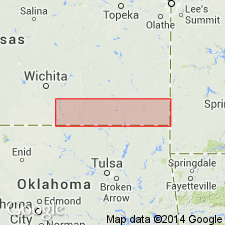
- Usage in publication:
-
- Mound Valley limestone
- Modifications:
-
- Original reference
- Dominant lithology:
-
- Limestone
- AAPG geologic province:
-
- Cherokee basin
Summary:
Pg. 23. Mound Valley limestone. Heavy limestone, thin to 15 feet thick, capping row of hills, 120 feet high, northwest of Mound Valley [Labette County, eastern Kansas] and passing under surface at Cherryvale [Montgomery County, eastern Kansas]. Age is Pennsylvanian.
Source: US geologic names lexicons (USGS Bull. 896, p. 1429; USGS Bull. 1200, p. 2618).

- Usage in publication:
-
- Mound Valley limestone†
- Modifications:
-
- Abandoned
Summary:
Discarded by the USGS many years ago, for Bethany Falls limestone, the older name. R.C. Moore, 1936 (Kans. Geol. Surv. Bull. 22, p. 86), discussed Adams' miscorrelatlons and gave synopses of Mound Valley limestone as used by other writers. On p. 88 he stated: Bethany Falls limestone was called †Mound Valley limestone by early Kansas Geol. Survey, but Bethany Falls has priority.
Source: US geologic names lexicon (USGS Bull. 896, p. 1429).
For more information, please contact Nancy Stamm, Geologic Names Committee Secretary.
Asterisk (*) indicates published by U.S. Geological Survey authors.
"No current usage" (†) implies that a name has been abandoned or has fallen into disuse. Former usage and, if known, replacement name given in parentheses ( ).
Slash (/) indicates name conflicts with nomenclatural guidelines (CSN, 1933; ACSN, 1961, 1970; NACSN, 1983, 2005, 2021). May be explained within brackets ([ ]).

